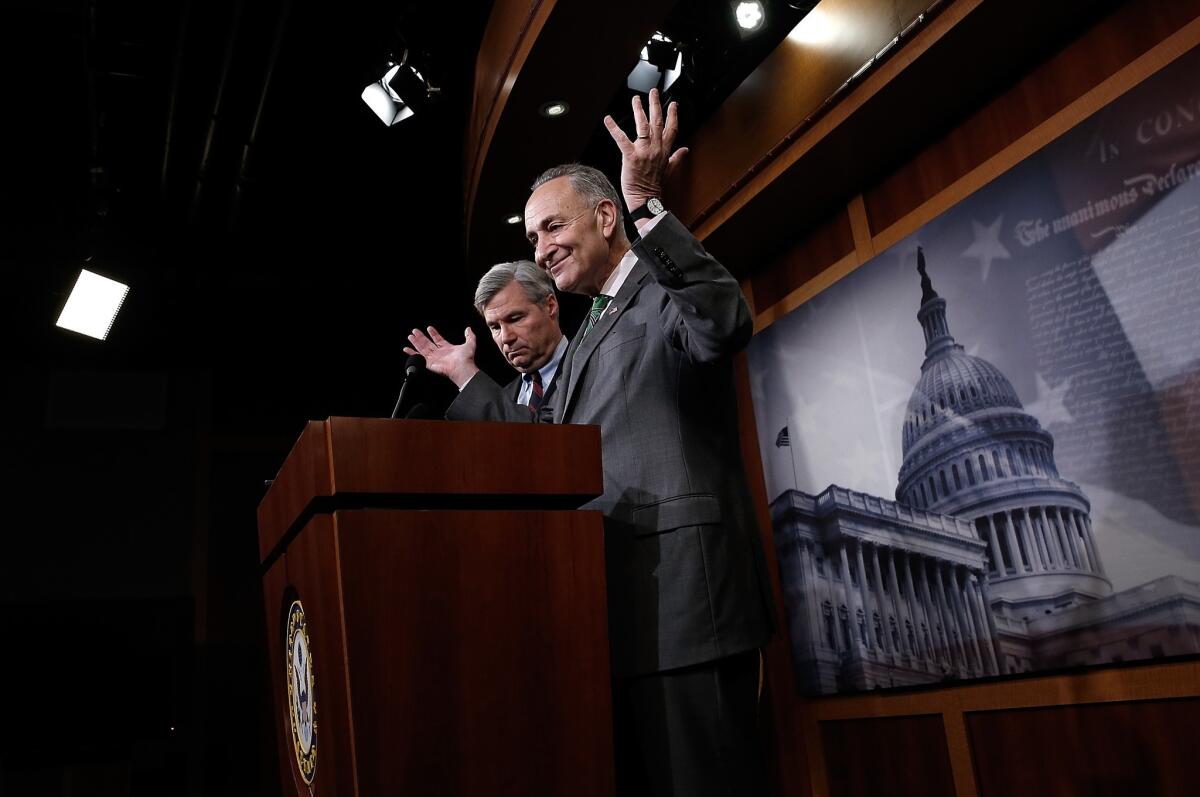Op-Ed: Supreme Court ruling: As if we don’t have enough money in politics already

- Share via
Thank you, Supreme Court. Before your decision Wednesday in McCutcheon vs. FEC, Americans were confined to giving a measly total of $48,600 in campaign contributions to federal candidates (enough for about nine candidates) and a total of $74,600 to political action committees. That means individuals were subject to aggregate contributions limits totaling a mere $123,200.
Of course, individuals could, and still can, give unlimited sums to independent groups, such as so-called super PACs and other nonprofit corporations. Much of this giving remains undisclosed. For instance, super PACs such as Restore Our Future, American Crossroads, Priorities USA Action and others spent almost $830 million in the 2012 election. Talk about constraints on one’s ability to participate in our electoral processes.
And how many people were handcuffed by these limits? Well, fewer than 600 donors, or 0.0000019% of Americans, gave the maximum amount under those oh-so-restrictive limits, according to the Center for Responsive Politics. And 0.1% of 310 million Americans give $2,500 or more in political campaigns.
Well, good news for you big donors: no more pesky aggregate contribution limits. Sure, you are still limited to giving only $5,200 per federal candidate ($2,600 for the primary and $2,600 for the general) and $5,000 annually per PAC. But now you can directly support as many candidates as you want.
As Justice Antonin Scalia noted in the October hearing in this case: “I don’t think $3.5 million is a heck of a lot of money.” That’s the total a single donor could give if he or she donated the maximum allowed in every congressional race in the nation.
But is this really what was envisioned in the wake of the Watergate scandal, when Congress sought to stem the flow of money in politics? Hardly. Our current campaign finance framework stands as a sad relic of the comprehensive system passed in the early 1970s, when Congress enacted the Federal Election Campaign Act, the nation’s first wide-ranging set of campaign finance restrictions. The law limited the amount that could be given to and spent by candidates and political committees. It also provided for disclosure of those sums. Disclosure may be the only way we can regulate the political money trail in the near future.
The weakening of campaign finance restrictions began in 1976 with a bungled but seminal decision in which the high court ruled that money should be viewed as speech. In Buckley vs. Valeo, the court upheld contribution limits (including the now-invalid aggregate contribution limits) but struck down the expenditure limits. And thus the court kicked off the endless fundraising race that is now such a familiar facet of political campaigns.
Although the Buckley ruling dealt a serious blow to the ability of government to limit the flow of money in politics, there was a period of deference to Congress and state legislatures that passed campaign finance restrictions. But in 2006, Justice Samuel A. Alito Jr. replaced Justice Sandra Day O’Connor, and since then the court has taken a hostile view of such limits. The court embraced a death-by-a-thousand-paper-cuts approach.
Its 2010 Citizens United ruling, which freed corporations and unions to spend unlimited amounts advocating for and against candidates, was more of an amputation than a paper cut. It was the most visible example of the court’s view. Well, that is until now.
Now donors have plenty of ways to provide money directly to candidates. They can give to joint fundraising committees, a candidate’s party’s PAC and on and on.
Where does McCutcheon leave us? It leaves people like me who believe it is both legal and good policy to limit the influence of money in politics in an existential crisis. As ever more money is injected into our political system, it is worth asking how we want that money to flow, whether it be through direct contributions, independent expenditures or another mechanism.
Our current system essentially limits only direct contributions from donors to candidates and political committees. But independent organizations receive and dispense vast sums related to candidate campaigns, and many do not have to disclose the donors of this dark money.
The base contribution limits could be the next restriction on the chopping block. If that’s the case, we must come up with better ways to create a system of true transparency.
Here’s looking at you, Congress, states and government agencies.
Jessica A. Levinson, an associate clinical professor at Loyola Law School-Los Angeles, is the vice president of the Los Angeles Ethics Commission. She blogs at PoLawTics.lls.edu. Twitter: @LevinsonJessica.
More to Read
A cure for the common opinion
Get thought-provoking perspectives with our weekly newsletter.
You may occasionally receive promotional content from the Los Angeles Times.









